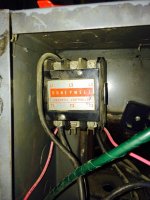Erikflor
Plastic
- Joined
- Feb 23, 2014
- Location
- Oceanside CA
I recently purchased a rotary phase converter to run a small CNC lathe in my shop. I wired it to the 220 single phase panel yesterday, flipped the switch and nothing good happened. My best explanation is that it quivers...like it turns back and forth but won't make up it's mind about which direction to turn. I tried over and over but continue to get the same results. I have also wrapped a string around the motor shaft to give it a spin before flipping power on, same results.
I'm not sure how big the motor is because it has no plate but my best guess would be 15hp. I have always used VFD's so this is my first run with a RPC. I'm wondering if I need to replace the magnetic controller??


I'm not sure how big the motor is because it has no plate but my best guess would be 15hp. I have always used VFD's so this is my first run with a RPC. I'm wondering if I need to replace the magnetic controller??




 ) There should be a set of capacitors which are temporarily put in circuit to phase shift the 3rd wire and get the idler motor turning. I was going to say they may not even be present, but they are at the bottom under the dust, with the orange wires.
) There should be a set of capacitors which are temporarily put in circuit to phase shift the 3rd wire and get the idler motor turning. I was going to say they may not even be present, but they are at the bottom under the dust, with the orange wires.